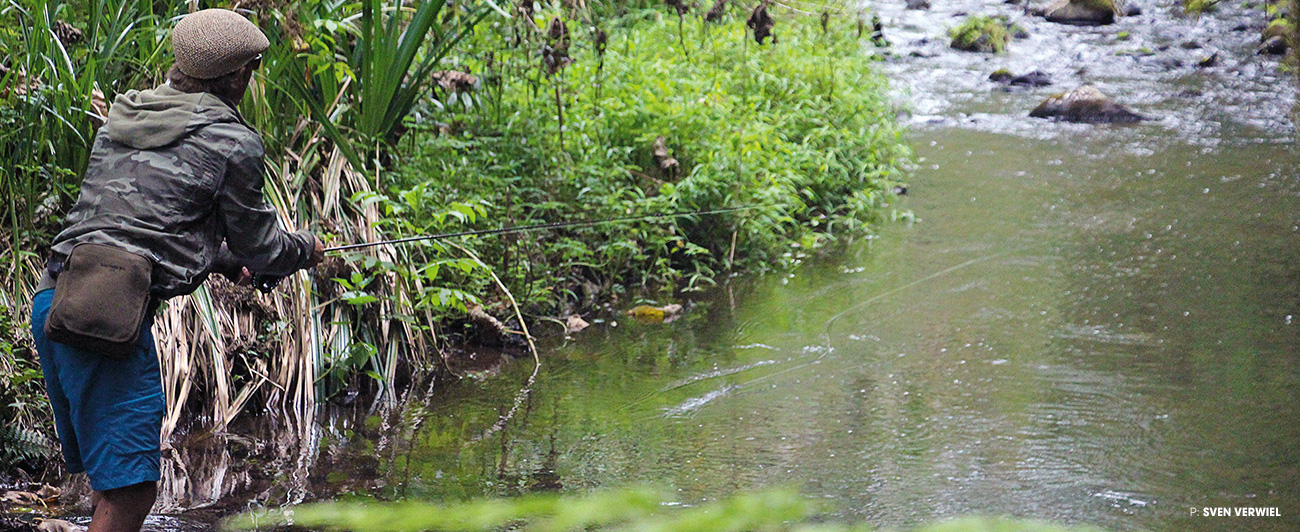Cutbank
Ragati Reds
above “Prior to exploring Kenya’s Ragati River, we’d only heard rumor of Ragati reds, a rainbow phenotype with blood-red flanks. The males show off large kypes and spawning battle scars, while the gorgeous hens are blessed with green-black spots no larger than specks of sand. This run proved perfect for the evening rise with the faint background sound of grazing buffalo and leopards beginning their evening hunt.”
Photo: Sven Verwiel
The small town of Nanyuki in central Kenya doesn’t see many tourists carrying fly rods. Early October meant the rainy season was just kicking off and I could smell the damp air when the alarm went off at 4:45 a.m
Outside in the warm drizzle, my driver Douglas was waiting. He’s not a chatty guy, at least not in the early morning. As we drove south across the equator I could see the silhouette of Mount Kenya in the soft morning light. Getting closer to the mountain, Douglas’ frustrated muttering told me he had no idea where he was going.
After studying the directions together, we eventually arrived at the Ragati Conservancy inside Mount Kenya National Park. The foggy mountain rainforest of the conservancy made getting beautifully lost on the drive up completely worthwhile. Michael, my gillie for the day, greeted me at the entrance and offered a selection of nymphs and a steaming mug of chai.
Michael gave me a toothy grin, picked up his machete and led the way into the damp forest. He told me with a chuckle that he wielded the blade to ensure an elephant didn’t trample me. At first I thought he was kidding. Then I saw the poop. Basketball-sized pieces of dung littered the path, the earthy smell wafting into my nostrils.
Quickly forgetting about elephants, I laid eyes on the picturesque Ragati River. It was my kind of stream—small but with character, dotted with mossy boulders and plunging waterfalls. I fished that pool. This run. That flat. Nothing. Michael’s jolly voice kept telling me the prince nymph was the way to go and I took him at his word.
I fished the nymph too long—three hours all the way up the river, only seeing one flash of a trout. It was rough going—lost flies, stinging nettles and elephant poop forever encrusted onto the bottom of my boots.
We came upon a large pool that Michael told me was very deep so I rigged up a double wooly bugger setup. I was only a few casts from giving up—hours of effort and all I had to show for it was shit. Literally.
Then, finally, fish on.
They call them Ragati reds. Equatorial rainbow trout with the brightest and deepest red stripe you will ever see. Their color combination matching the beauty and grandeur of a Serengeti sunset. Just like that, one fish changed the whole day.
I walked back downriver, this time catching fish left and right on the bugger. It was almost 5 p.m. and sunlight was waning. I knew I was making some of my final casts. I took a shot downstream in some slow-moving water. The bugger hadn’t been submerged for more than a second before the end of my fly line shot across the river. I got a glimpse of him and almost lost it—a Ragati red with spectacular hues and highlights brighter than any of the fish I had caught earlier in the day. I had to land this fish. I brought him in slowly, rod bent, arms sore and shaking. Finally, my last Ragati red came to hand—a magnificent sunset of a trout to cap off an unforgettable day.
Michael gave me a high-five before telling me it was time to go. I took a moment at the river. The subtle gurgle of the pool filled my ears. The humid warmth of the forest soothed my skin. The gorgeous Kenyan sunset pleased my eyes. The smell of elephant poop filled my nose. It smelled like victory.
This story originally appeared in The Flyfish Journal Volume 8 Issue 3.
